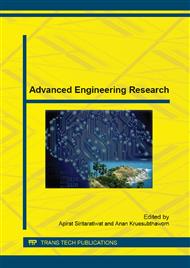p.292
p.296
p.300
p.304
p.308
p.312
p.316
p.321
p.325
3-D Computational Simulations of Electrostatic Potential in Partial Surfaces towards the Precision of Ion Balance Analysis
Abstract:
This paper reports a 3-D computational simulation of electrostatic potential uniformity which was affected by various measurement plates. The finite element analysis method has been done by COMSOL Multiphysics to model the electrostatic potential behavior. The electrostatic potential from two electrodes in the free space plane has been modeled and used as a reference result to compare with the electrostatic potential results of four various measurement plates including the standard 6"x6" charged plate and its dividing by four, nine and sixteen segments. This investigation revealed the uniformity error of the electrostatic potential from the conventional plate. The precision of ion balance analysis can be improved by the using of a partial surface, i.e. by dividing the conventional plate into smaller sizes.
Info:
Periodical:
Pages:
308-311
Citation:
Online since:
August 2015
Price:
Сopyright:
© 2015 Trans Tech Publications Ltd. All Rights Reserved
Share:
Citation:


